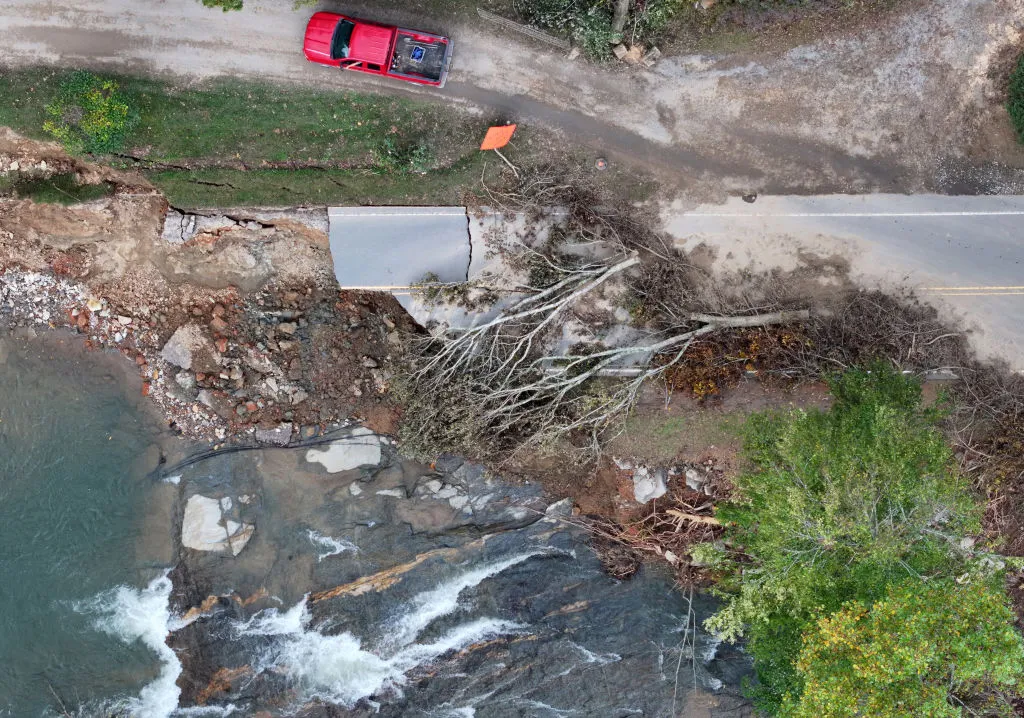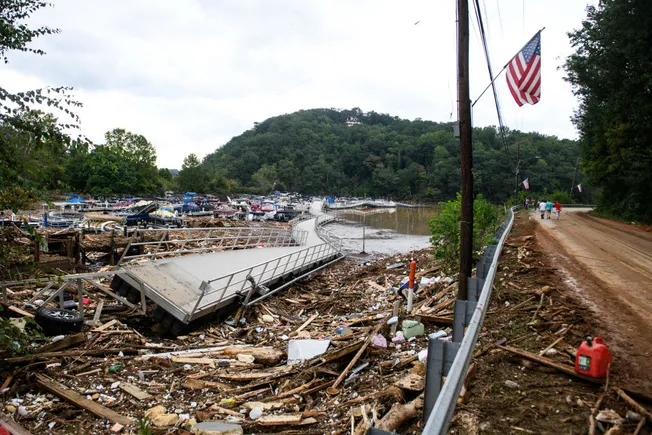Hurricane Helene tore through the Southeast at the end of September, destroying roads and bridges, knocking out electricity and cell service, sweeping away homes and killing at least 227 people. State DOTs are assessing the state of their infrastructure, as FEMA continues search and rescue and other emergency support.
The Category 4 storm was the most lethal hurricane to hit the mainland U.S. since Katrina in 2005, and the rebuilding needs, which are still coming into focus, will be massive.
Western North Carolina suffered the worst of the damage, and Tennessee, Georgia, South Carolina, Virginia and Florida — where it first hit the coast on Sept. 26 — are also dealing with the aftermath. The far-reaching storm knocked out power in those states as well as in Indiana, Kentucky, Ohio and West Virginia.
Many Floridians, still reeling from Helene, are now fleeing another Category 4 storm and Florida DOT is pivoting from recovery to preparation. Fast-growing Hurricane Milton is expected to make landfall in the Tampa Bay area on Wednesday and looks to be one of the worst to hit the area in 100 years.
Rebuilding will be expensive
Preliminary estimates place the price of rebuilding from Helene in the tens of billions: On the lower end is $30.5 to $47.5 billion, from CoreLogic, a California-based financial and consumer analytics company, while forecasting company AccuWeather pegs it from $225 to $250 billion. Many of the affected homes are uninsured, according to climate news site Grist.
President Joe Biden asked Congress on Friday to quickly replenish disaster relief funds to help. As of Monday, FEMA says it has provided more than $210 million in emergency assistance to affected areas of Georgia, Florida, North Carolina, South Carolina, Tennessee and Virginia for items such as food, generators and tarps.
The federal government is sending another $100 million to repair and reopen roads and bridges damaged by Helene in western North Carolina, the Federal Highway Administration said Saturday, as well as $32 million in relief for Tennessee and $2 million for South Carolina. Where funding will come from for the rest of the repairs remains to be seen.

An aerial view of vehicle bypassing a stretch of roadway washed away by flooding wrought by Hurricane Helene on Oct. 3 in Black Mountain, North Carolina.
Mario Tama via Getty Images
Here is an overview of the infrastructure that has been damaged:
Roads and bridges
Hundreds of roads remain closed in the aftermath of Helene, according to the New York Times, and washouts, mudslides and debris severed many routes in the Appalachian Mountains. Three bridges were washed away in southwest Virginia.
Perhaps the most consequential destruction is to I-40, where a mudslide and raging water ripped through the portion of the highway connecting western North Carolina and eastern Tennessee. Repairing roads and bridges near the North Carolina-Tennessee border could take months and promises to be a major planning and political challenge, per the New York Times.
As of Tuesday, 734 of the state’s roads were still closed or impassable due to the hurricane, according to North Carolina DOT, and the Tennessee DOT says many routes in the eastern part of the state require significant repairs and others have to be totally rebuilt.
Electrical grid and cell phone towers
Helene knocked out power for almost 6 million customers in 10 states, according to the Edison Electric Institute, which represents investor-owned utilities. Many electrical grids need repairs and many others have to be rebuilt entirely, according to Utility Dive.
In North Carolina, 111,102 customers are still without power, according to the PowerOutage tracker, as are roughly 60,000 households in Georgia and 21,000 in South Carolina. Utilities say they cannot estimate restoration times, in some cases, because roads are impassable and grids must be reconstructed, per Utility Dive.
The storm also destroyed cell phone towers, severing communication for potentially millions of people, according to USA Today.
Water, sewage and dams
Helene’s flooding badly damaged water infrastructure, including sewage systems, wastewater treatment plants, dams and pipes that deliver drinking water to residents in North Carolina, Florida, Georgia, Tennessee and Virginia.
Above- and below-ground water systems were destroyed in western North Carolina, and area officials said repairs could take several weeks, according to the New York Times. Some east Tennessee counties also lost their clean water supply when their treatment plants were damaged.
The Nolichucky Dam near Greeneville, Tennessee, and North Carolina’s Walters and Lake Lure dams came close to failing, forcing an evacuation of nearby communities. Although the dams ultimately held, the incident illustrates how many of the structures are unprepared for an era of extreme weather and pose an imminent risk of failure.
Rail
The storm blocked off rail lines in affected states with fallen trees and other debris. In particular, Helene flooded tracks and damaged bridges on CSX routes in the Carolinas, according to Railway Track and Structures, and Norfolk Southern is also dealing with downed power lines.

A lane of Main Street is seen washed away by flood waters in the aftermath of Hurricane Helene on Sept. 30 in Old Fort, North Carolina.
Melissa Sue Gerrits via Getty Images
Helene highlights vulnerabilities
Hurricane Helene illustrates how communities and infrastructure across the U.S. are unprepared for the extreme weather driven by climate change.
Notably, Helene struck communities that had been considered relatively safe from extreme weather. For example, it devastated Asheville, North Carolina, located nearly 500 miles from where the hurricane made landfall and widely considered a climate haven.
The world’s climate is changing more quickly than building codes are being updated. The National Flood Insurance Program minimum standards — the basis of flood codes across the country — have not been updated in 46 years, and the U.S. also lacks consistent flood design standards for infrastructure, according to Chad Berginnis, executive director for the Association of State Floodplain Managers.
Marsia Geldert-Murphey, president of the American Society of Civil Engineers, said in a news release that Helene is a reminder of the importance of widespread adoption of up-to-date building codes and standards.
“As someone who has experienced losing everything in a catastrophic flood event, I have seen first-hand the need for making communities more resilient, and the consequences of failing to do so,” said Geldert-Murphey in the release. “Extreme weather events and 500-year floods are increasing in regularity and our aging infrastructure systems were not built to withstand storms of this magnitude.”

